-
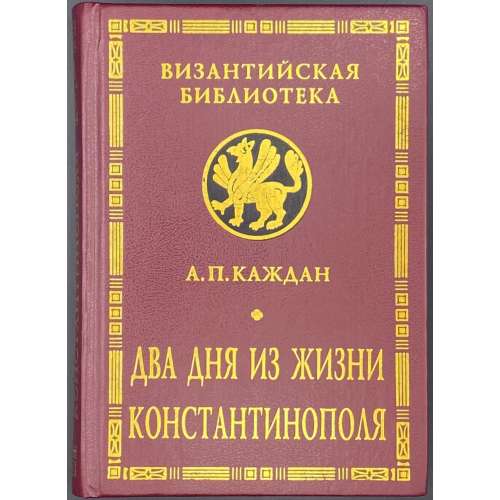 Title: А. П. КАЖДАН | ДВА ДНЯ | ИЗ ЖИЗНИ | КОНСТАНТИНОПОЛЯ | Научное издание | Издательство «АЛЕТЕЙЯ» | Санкт-Петербург | 2002 || Series: Византийская библиотека. Исследования. Pagination: [1-5] 6-318 [2], il. in text. Binding: 17 x 12.5 cm; hardcover, crimson buckram, gilt lettering, border and serial device on black. Print run: 1,300 copies. ISBN: 5-89329-463-7. Каждан, Александр Петрович [Пейсахович] [Kazhdan, Alexander] (Russian-American, 1922 – 1997).
Title: А. П. КАЖДАН | ДВА ДНЯ | ИЗ ЖИЗНИ | КОНСТАНТИНОПОЛЯ | Научное издание | Издательство «АЛЕТЕЙЯ» | Санкт-Петербург | 2002 || Series: Византийская библиотека. Исследования. Pagination: [1-5] 6-318 [2], il. in text. Binding: 17 x 12.5 cm; hardcover, crimson buckram, gilt lettering, border and serial device on black. Print run: 1,300 copies. ISBN: 5-89329-463-7. Каждан, Александр Петрович [Пейсахович] [Kazhdan, Alexander] (Russian-American, 1922 – 1997). -
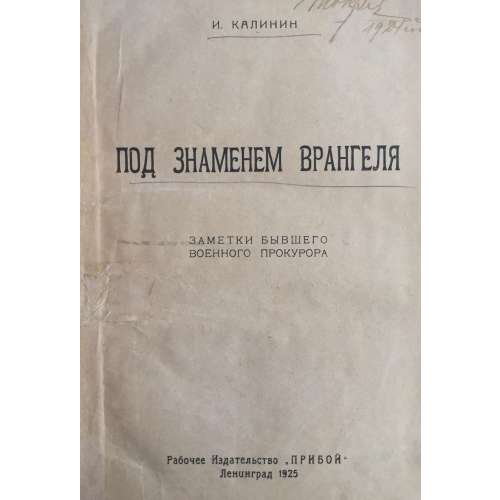
И. М. Калинин. Под знаменем Врангеля. Заметки бывшего военного прокурора. - Л.: Рабочее из-во "Прибой", 1925. - 273 с.
Тираж 7125 экз.
Об авторе: «К моменту февральской революции я занимал должность помощника военного прокурора Кавказского военно-окружного суда... Я не был политиком, но не переносил Союза русского народа. Падение монархии приветствовал. В 1917 году в г. Эрзеруме, занимая довольно приличный пост, работал в самом тесном содружестве с Советом солдатских и рабочих депутатов. Меньшевики, эсэры, большевики постоянно навещали меня, зная, что я хотя и внепартийный, но искренно предан делу революции». В 1918-м Калинину удалось перебраться в занятый Добровольческой армией Екатеринодар, откуда в конце сентября 1918 г. он выехал на Дон. «Здесь тоже мобилизовали всех офицеров. Мне ничего другого не оставалось, как поступить на службу в только что сорганизованный Донской военно-окружной суд». Будучи профессиональным военным юристом Калинин в дальнейшем состоял прокурором при временном Донском военном суде.
По возвращении из эмиграции полковник Калинин, как и многие другие репатрианты, пытался избавиться от клейма «бывшего белогвардейца». 5 октября 1937 г. И. М. Калинин, в то время преподаватель рабочего факультета Ленинградского автодорожного института, был арестован по решению Комиссии НКВД и Прокуратуры СССР . 2 ноября 1937 г. он был приговорен по ст. 58-6-8-11 УК РСФСР к высшей мере наказания и расстрелян в Ленинграде 10 ноября 1937 года.
-
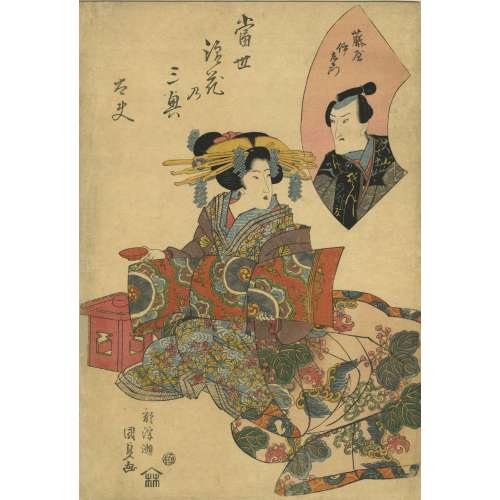 The central sheet of (optional) triptych: Courtesan (Tayū): kabuki actor Bandō Mitsugorō III as Fujiya Izaemon from Three pleasures of present-day Osaka (Tōsei Naniwa no sankō)「当世浪花の三興 太夫」 「藤屋伊左衛門」 三代目坂東三津五郎. Publisher: Iseya Rihei [伊勢屋利兵衛] (Japanese, fl. 1790s – c. 1879) Year: 1821 (Bunsei 4). Size: Vertical ōban; 36.5 x 25.1 cm. Signed: 於浮瀬亭国貞画 – Drawn by Kunisada in Ukabuse (Ukabuse ni oite Kunisada ga). Ukabuse is the name of a famous restaurant in Osaka, this signature can be found only on a three print bijin series [Kunisada Project]. Censor's seal: kiwame 改印:極 Actor Bandō Mitsugorō III [三代目 坂東 三津五郎] (Japanese, 1775 – 1831); other names: Bandō Minosuke I, Morita Kanjirô II, Bandō Mitahachi I, Bandō Minosuke I, Bandō Mitahachi I. Character: Fujiya Izaemon. Ref: MFA ACCESSION NUMBER 11.21937; LIB-2967.2022 Izzard. Full series (triptych) Three Pleasures of Present-day Osaka (Tōsei Naniwa no sankō):
The central sheet of (optional) triptych: Courtesan (Tayū): kabuki actor Bandō Mitsugorō III as Fujiya Izaemon from Three pleasures of present-day Osaka (Tōsei Naniwa no sankō)「当世浪花の三興 太夫」 「藤屋伊左衛門」 三代目坂東三津五郎. Publisher: Iseya Rihei [伊勢屋利兵衛] (Japanese, fl. 1790s – c. 1879) Year: 1821 (Bunsei 4). Size: Vertical ōban; 36.5 x 25.1 cm. Signed: 於浮瀬亭国貞画 – Drawn by Kunisada in Ukabuse (Ukabuse ni oite Kunisada ga). Ukabuse is the name of a famous restaurant in Osaka, this signature can be found only on a three print bijin series [Kunisada Project]. Censor's seal: kiwame 改印:極 Actor Bandō Mitsugorō III [三代目 坂東 三津五郎] (Japanese, 1775 – 1831); other names: Bandō Minosuke I, Morita Kanjirô II, Bandō Mitahachi I, Bandō Minosuke I, Bandō Mitahachi I. Character: Fujiya Izaemon. Ref: MFA ACCESSION NUMBER 11.21937; LIB-2967.2022 Izzard. Full series (triptych) Three Pleasures of Present-day Osaka (Tōsei Naniwa no sankō):


-
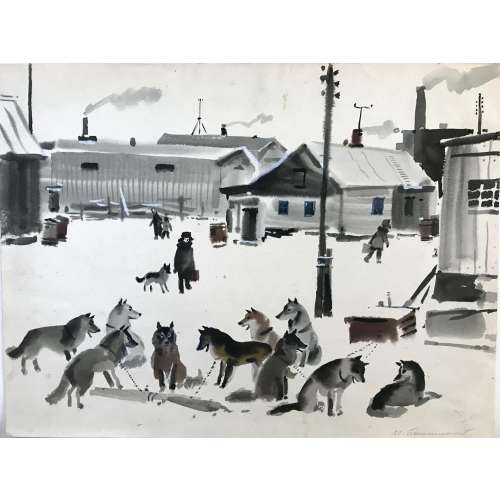 Mikhail Belomlinsky. Born 1934, Russia. Village, dogs. Watercolor painting on paper from Chukotka expedition, 1975. Size: 36 x 48 cm.
Mikhail Belomlinsky. Born 1934, Russia. Village, dogs. Watercolor painting on paper from Chukotka expedition, 1975. Size: 36 x 48 cm. -
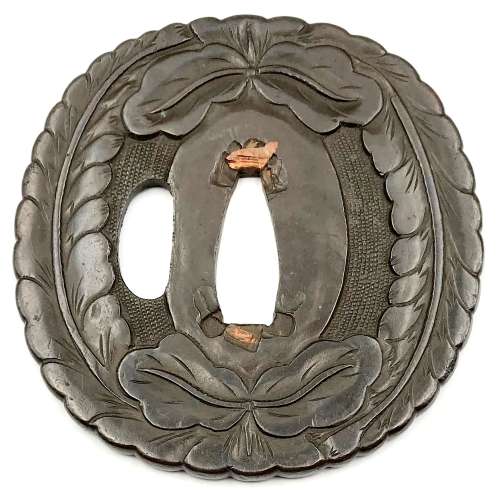 A yamagane (unrefined copper) ko-kinko tsuba of slightly elongated round form with design of wisteria carved in sculptural relief (nikubori). Copper sekigane. Unsigned. Muromachi period, likely the 16th century.
A yamagane (unrefined copper) ko-kinko tsuba of slightly elongated round form with design of wisteria carved in sculptural relief (nikubori). Copper sekigane. Unsigned. Muromachi period, likely the 16th century.Size: 74.3 x 71.8 x 3.2 mm.
NBTHK certificate №4003986: Hozon (worthy preservation). In custom wooden box. -
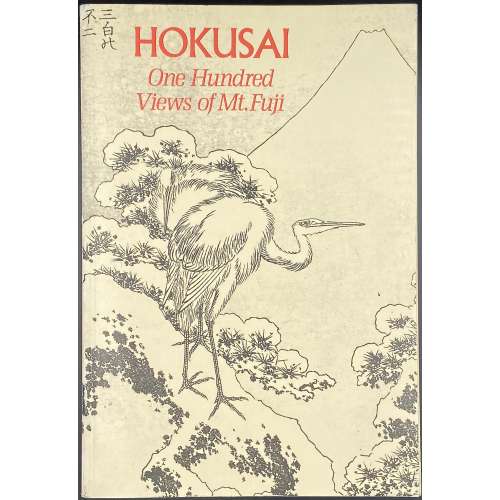 Softcover, 24 x 16.5 cm, publisher's pictorial wrappers, lettering to spine, pp.: [6] 7-224. Full reproduction of Katsushika Hokusai's [葛飾 北斎] (Japanese, 1760 – 1849) series of three illustrated books [絵本, e-hon] One Hundred Views of Mount Fuji [富嶽百景, Fugaku hyakkei], published in Japan in 1834-1849, with commentaries.
Softcover, 24 x 16.5 cm, publisher's pictorial wrappers, lettering to spine, pp.: [6] 7-224. Full reproduction of Katsushika Hokusai's [葛飾 北斎] (Japanese, 1760 – 1849) series of three illustrated books [絵本, e-hon] One Hundred Views of Mount Fuji [富嶽百景, Fugaku hyakkei], published in Japan in 1834-1849, with commentaries. -
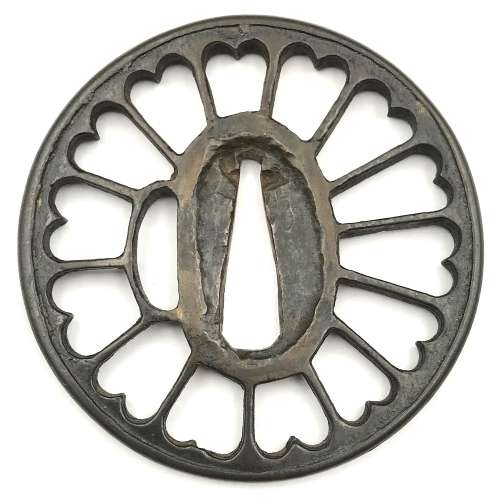 Yamagane tsuba of round form with design of a 14 petal chrysanthemum (kiku) in cast openwork (sukashi), with slightly raised rounded rim. Early Muromachi period (1393-1457). Size: Height: 64.5 mm; Width: 64.0 mm; Thickness at seppa-dai: 4.1 mm; Weight: 52.5 g. Provenance: Sasano collection (though not illustrated in the book 'Sasano: Japanese Sword Guard Masterpieces from the Sasano Collection, 1994', which only covers tsuba made of iron). Wooden box (tomobako) with inscription (hakogaki) by Sasano Masayuki. References: Illustrated on p. 140 at Tosogu: Treasure of the samurai by Graham Gemmell in the article Muromachi period tsuba by Robin Peverett, London, 1991, pp. 131-145. Sold at Sotheby's, London, Thursday 10 April 1997 Sotheby's, London, 1997 [Japanese Swords and Tsuba from the Professor A.Z. Freeman and the Phyllis Sharpe Memorial collections], p. 16: "A ko-kinko bronze Tsuba, early Muromachi period (1393-1453) of circular form, with raised rounded rim, pierced with kiku petals and with a small elongated kozuka-hitsu, the work appearing to be cast and finished by hand. 6.4cm, thickness at centre 4.15mm, at rim 4.8mm. With a Tomobako, bearing a hakogaki by Masayuki Sasano, with rating Shu. Estimated: £1,000-1,500." Hakogaki (courtesy M. Sesko): 古金工 鐔 Ko-Kinkō tsuba 菊花透 無銘 山銅地透 時代 室町前期 古雅入念 秀作 昭和戊辰年伏月 素心鑑 kikka-sukashi, mumei yamagane, ji-sukashi jidai Muromachi-zenki koga nyūnen, shūsaku Showa tsuchinoe-tatsudoshi fukugetsu Soshinkan Kikka-sukashi, unsigned. Of yamagane and with ji-sukashi. Era is early Muromachi period. Excellent and carefully made work of classical elegance. June in the year of the dragon of the Shōwa era (1988) Soshinkan (pen name of Sasano Masayuki).
Yamagane tsuba of round form with design of a 14 petal chrysanthemum (kiku) in cast openwork (sukashi), with slightly raised rounded rim. Early Muromachi period (1393-1457). Size: Height: 64.5 mm; Width: 64.0 mm; Thickness at seppa-dai: 4.1 mm; Weight: 52.5 g. Provenance: Sasano collection (though not illustrated in the book 'Sasano: Japanese Sword Guard Masterpieces from the Sasano Collection, 1994', which only covers tsuba made of iron). Wooden box (tomobako) with inscription (hakogaki) by Sasano Masayuki. References: Illustrated on p. 140 at Tosogu: Treasure of the samurai by Graham Gemmell in the article Muromachi period tsuba by Robin Peverett, London, 1991, pp. 131-145. Sold at Sotheby's, London, Thursday 10 April 1997 Sotheby's, London, 1997 [Japanese Swords and Tsuba from the Professor A.Z. Freeman and the Phyllis Sharpe Memorial collections], p. 16: "A ko-kinko bronze Tsuba, early Muromachi period (1393-1453) of circular form, with raised rounded rim, pierced with kiku petals and with a small elongated kozuka-hitsu, the work appearing to be cast and finished by hand. 6.4cm, thickness at centre 4.15mm, at rim 4.8mm. With a Tomobako, bearing a hakogaki by Masayuki Sasano, with rating Shu. Estimated: £1,000-1,500." Hakogaki (courtesy M. Sesko): 古金工 鐔 Ko-Kinkō tsuba 菊花透 無銘 山銅地透 時代 室町前期 古雅入念 秀作 昭和戊辰年伏月 素心鑑 kikka-sukashi, mumei yamagane, ji-sukashi jidai Muromachi-zenki koga nyūnen, shūsaku Showa tsuchinoe-tatsudoshi fukugetsu Soshinkan Kikka-sukashi, unsigned. Of yamagane and with ji-sukashi. Era is early Muromachi period. Excellent and carefully made work of classical elegance. June in the year of the dragon of the Shōwa era (1988) Soshinkan (pen name of Sasano Masayuki). -
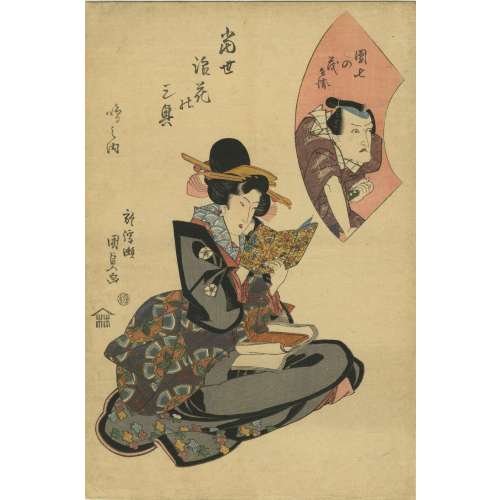 The left sheet of (optional) triptych: Geisha of the Shimanouchi district: Actor Nakamura Utaemon III as Danshichi no Mohei, from Three Pleasures of Present-day Osaka (Tōsei Naniwa no sankō)「当世浪花の三興 島之内」 「団七の茂兵衛」 三代目中村歌右衛門. Publisher: Iseya Rihei [伊勢屋利兵衛] (Japanese, fl. 1790s – c. 1879) Year: 1821 (Bunsei 4). Size: Vertical ōban; 36.5 x 25.1 cm. Signed: 於浮瀬亭国貞画 – Drawn by Kunisada in Ukabuse (Ukabuse ni oite Kunisada ga). Ukabuse is the name of a famous restaurant in Osaka, this signature can be found only on a three print bijin series [Kunisada Project]. Censor's seal: kiwame 改印:極 Actor Nakamura Utaemon III [中村歌右衛門] (Japanese, 1778 – 1838); other names: Nakamura Tamasuke, Nakamura Baigyoku I, Nakamura Shikan I, Kagaya Fukunosuke I. Character: Danshichi no Mohei [団七茂兵衛]. Ref: MFA ACCESSION NUMBER 11.21936; LIB-2967.2022 Izzard. Full series (triptych) Three Pleasures of Present-day Osaka (Tōsei Naniwa no sankō):
The left sheet of (optional) triptych: Geisha of the Shimanouchi district: Actor Nakamura Utaemon III as Danshichi no Mohei, from Three Pleasures of Present-day Osaka (Tōsei Naniwa no sankō)「当世浪花の三興 島之内」 「団七の茂兵衛」 三代目中村歌右衛門. Publisher: Iseya Rihei [伊勢屋利兵衛] (Japanese, fl. 1790s – c. 1879) Year: 1821 (Bunsei 4). Size: Vertical ōban; 36.5 x 25.1 cm. Signed: 於浮瀬亭国貞画 – Drawn by Kunisada in Ukabuse (Ukabuse ni oite Kunisada ga). Ukabuse is the name of a famous restaurant in Osaka, this signature can be found only on a three print bijin series [Kunisada Project]. Censor's seal: kiwame 改印:極 Actor Nakamura Utaemon III [中村歌右衛門] (Japanese, 1778 – 1838); other names: Nakamura Tamasuke, Nakamura Baigyoku I, Nakamura Shikan I, Kagaya Fukunosuke I. Character: Danshichi no Mohei [団七茂兵衛]. Ref: MFA ACCESSION NUMBER 11.21936; LIB-2967.2022 Izzard. Full series (triptych) Three Pleasures of Present-day Osaka (Tōsei Naniwa no sankō):


-
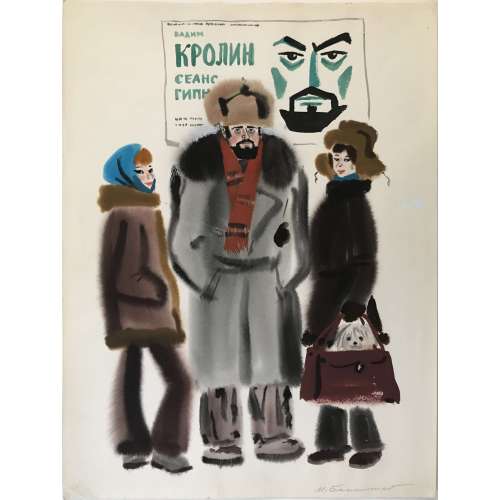 Mikhail Belomlinsky. Born 1934, Russia. Vadim Krolin, hypnosis session. Watercolor painting on paper from Chukotka expedition, ca. 1970s. Size: 36 x 48 cm.
Mikhail Belomlinsky. Born 1934, Russia. Vadim Krolin, hypnosis session. Watercolor painting on paper from Chukotka expedition, ca. 1970s. Size: 36 x 48 cm. -
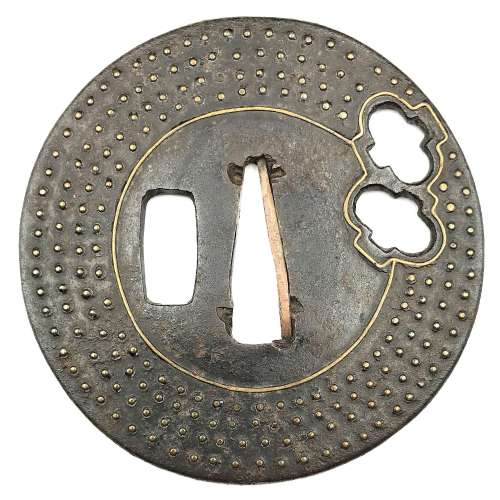 Iron tsuba of round form with design of two paper lanterns in openwork (small cut-outs, ko-sukashi ) outlined with brass wire. The plate is decorated with four concentric rows of brass dot inlay (ten-zōgan), with a brass circular wire inside the innermost row of dots (missing on the back). Hitsu-ana of rectangular form is not outlined with brass wire, which let us suppose that it was cut out at a later date. Copper sekigane. Mid Muromachi period (1454-1513). Diameter: 74.0 mm, thickness: 2.6 mm. Tsuba is illustrated at: 新版 日本刀講座 小道具鑑定編 本間 薫山 佐藤 寒山 : Shinhan Nihonto Koza, Volume VI, Kodogu Part 1. Under supervision of Honma Kunzan and Sato Kanzan. 鍔 無名 応仁 鉄地) 丸形 小透 槌目 真鍮据文 点象嵌 丸耳 : Tsuba with no signature, Ōnin style. Base metal iron (jigane), round shape, small perforations (ko-sukashi), hammering finish (tsuchime). Pre-cast brass inlay (shinchu suemon-zōgan); dot inlay (ten-zōgan); round edge (maru-mimi).
Iron tsuba of round form with design of two paper lanterns in openwork (small cut-outs, ko-sukashi ) outlined with brass wire. The plate is decorated with four concentric rows of brass dot inlay (ten-zōgan), with a brass circular wire inside the innermost row of dots (missing on the back). Hitsu-ana of rectangular form is not outlined with brass wire, which let us suppose that it was cut out at a later date. Copper sekigane. Mid Muromachi period (1454-1513). Diameter: 74.0 mm, thickness: 2.6 mm. Tsuba is illustrated at: 新版 日本刀講座 小道具鑑定編 本間 薫山 佐藤 寒山 : Shinhan Nihonto Koza, Volume VI, Kodogu Part 1. Under supervision of Honma Kunzan and Sato Kanzan. 鍔 無名 応仁 鉄地) 丸形 小透 槌目 真鍮据文 点象嵌 丸耳 : Tsuba with no signature, Ōnin style. Base metal iron (jigane), round shape, small perforations (ko-sukashi), hammering finish (tsuchime). Pre-cast brass inlay (shinchu suemon-zōgan); dot inlay (ten-zōgan); round edge (maru-mimi).
 English translation of the book indicated above Nihon Tō Kōza, Volume VI, Part 1 by Harry Afu Watson, AFU Research Enterprises, Inc., 1993. Tsuba in question illustrated on page 14 and described as follows: " Tsuba mumei Ōnin. Tetsu ji maru gata ko-sukashi tsuchime shitate shinchū suemon ten zogan maru mimi. Brass suemon". My question remains: why such a text is called 'translation' while it looks more like transliteration of romanization?
English translation of the book indicated above Nihon Tō Kōza, Volume VI, Part 1 by Harry Afu Watson, AFU Research Enterprises, Inc., 1993. Tsuba in question illustrated on page 14 and described as follows: " Tsuba mumei Ōnin. Tetsu ji maru gata ko-sukashi tsuchime shitate shinchū suemon ten zogan maru mimi. Brass suemon". My question remains: why such a text is called 'translation' while it looks more like transliteration of romanization? -
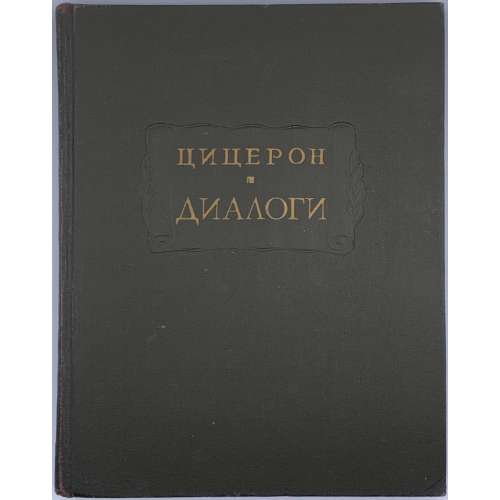 Title (black and red): ЦИЦЕРОН | ДИАЛОГИ | О ГОСУДАРСТВЕ 〜 О ЗАКОНАХ | ИЗДАНИЕ ПОДГОТОВИЛИ | И. Н. ВЕСЕЛОВСКИЙ, В. О. ГОРЕНШТЕЙН | и С. Л. УТЧЕНКО | {device} | ИЗДАТЕЛЬСТВО • НАУКА | МОСКВА • 1966 || Frontispiece (black and red): M. TVLLI CICERONIS | DIALOGI | DE REPUBLICA 〜 DE LEGIBUS| {device} || Pagination: [1-7] 8-223 [224], insert errata slip, 2 plates. Collation: 8vo; [1]8 2-148. Binding: 22 x 17.3 cm; hardbound: original serial green cloth, blind-stamped with scrolls and gilt lettering to board and spine, lacking DJ. Веселовский, Иван Николаевич (Russian, 1892 – 1977); Горенштейн, Виктор Осипович (Russian, 20th century); Утченко, Сергей Львович (Russian, 1908 – 1976).
Title (black and red): ЦИЦЕРОН | ДИАЛОГИ | О ГОСУДАРСТВЕ 〜 О ЗАКОНАХ | ИЗДАНИЕ ПОДГОТОВИЛИ | И. Н. ВЕСЕЛОВСКИЙ, В. О. ГОРЕНШТЕЙН | и С. Л. УТЧЕНКО | {device} | ИЗДАТЕЛЬСТВО • НАУКА | МОСКВА • 1966 || Frontispiece (black and red): M. TVLLI CICERONIS | DIALOGI | DE REPUBLICA 〜 DE LEGIBUS| {device} || Pagination: [1-7] 8-223 [224], insert errata slip, 2 plates. Collation: 8vo; [1]8 2-148. Binding: 22 x 17.3 cm; hardbound: original serial green cloth, blind-stamped with scrolls and gilt lettering to board and spine, lacking DJ. Веселовский, Иван Николаевич (Russian, 1892 – 1977); Горенштейн, Виктор Осипович (Russian, 20th century); Утченко, Сергей Львович (Russian, 1908 – 1976). -
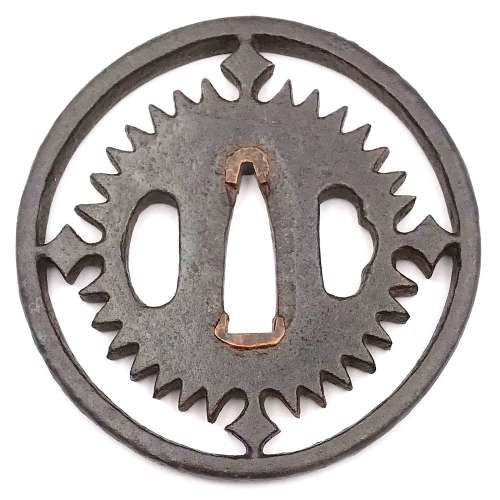 Iron tsuba of round form with design of slanting rays of light (shakoh) or clock gear (tokei) in openwork (sukashi). Commonly considered a Christian / Jesuit motif. Round-cornered rim. Copper sekigane. Momoyama period: Late 16th century (Tensho/Keicho era). Height: 72.5 mm, Width: 72.2 mm, Rim thickness: 5.5 mm, Center thickness: 5.3 mm. Round-cornered rim. Provenance: Sasano collection. Sasano Masayuki, Japanese Sword Guards Masterpieces from The Sasano Collection, Part I, № 136: "The general belief that this design represents the gear of a clock is erroneous, rather it shows the slanting rays of light from a cross, with the small diamond shapes representing the upright and transverse bars. The Christian influence is obvious..."
Iron tsuba of round form with design of slanting rays of light (shakoh) or clock gear (tokei) in openwork (sukashi). Commonly considered a Christian / Jesuit motif. Round-cornered rim. Copper sekigane. Momoyama period: Late 16th century (Tensho/Keicho era). Height: 72.5 mm, Width: 72.2 mm, Rim thickness: 5.5 mm, Center thickness: 5.3 mm. Round-cornered rim. Provenance: Sasano collection. Sasano Masayuki, Japanese Sword Guards Masterpieces from The Sasano Collection, Part I, № 136: "The general belief that this design represents the gear of a clock is erroneous, rather it shows the slanting rays of light from a cross, with the small diamond shapes representing the upright and transverse bars. The Christian influence is obvious..." -
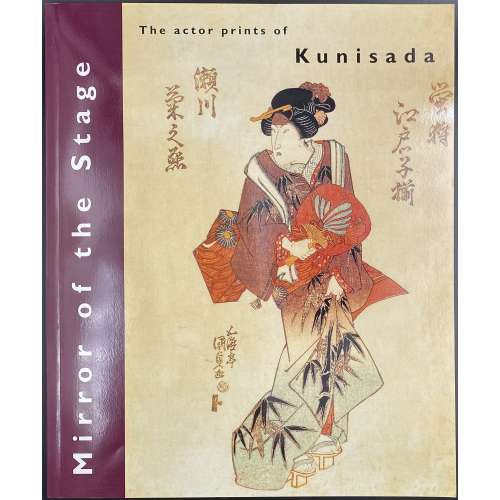 Thin booklet in glossy pictorial wrappers, 29.8 x 24.7 cm, pp.: [1-4] 5-48, 24 leaves total, illustrated. Errata tipped in after the front wrapper. Title-page: Mirror | of the stage | The actor prints of | Kunisada | Ellis Tinios | The University Gallery Leeds || Colophon: Published in March 1996 for the exhibition Mirror of the Stage held at the University Gallery Leeds 24 April-30 May 1996. Introduction: "This book [exhibition catalogue] has been written as an introduction to nineteenth-century Japanese colour woodblock actor prints and to the achievements of the artist Kunisada in that field [as well as to accompany the exhibition of the same name]. It is divided into three sections. In the first, I examine four topics: the social and cultural milieu that gave rise to the production of prints as items of mass consumption; the aesthetic of the actor print; the economics of print production (including consideration of the numbers issued, the prices at which they were sold and their rates of survival); and the process by which prints were produced. The second section consists of sixteen colour plates with commentaries. In the final section, I survey Kunisada's career." Subject: Utagawa, Kunisada, — 1786-1864 — Exhibitions; Ukiyo-e — Exhibitions; Colour prints, Japanese — Edo period, 1600-1868 — Exhibitions. Contributors: Ellis Tinios Utagawa Kunisada [歌川 国貞] a.k.a. Utagawa Toyokuni III [三代歌川豊国] (Japanese, 1786 – 1865). Select illustrations (references in this collection):
Thin booklet in glossy pictorial wrappers, 29.8 x 24.7 cm, pp.: [1-4] 5-48, 24 leaves total, illustrated. Errata tipped in after the front wrapper. Title-page: Mirror | of the stage | The actor prints of | Kunisada | Ellis Tinios | The University Gallery Leeds || Colophon: Published in March 1996 for the exhibition Mirror of the Stage held at the University Gallery Leeds 24 April-30 May 1996. Introduction: "This book [exhibition catalogue] has been written as an introduction to nineteenth-century Japanese colour woodblock actor prints and to the achievements of the artist Kunisada in that field [as well as to accompany the exhibition of the same name]. It is divided into three sections. In the first, I examine four topics: the social and cultural milieu that gave rise to the production of prints as items of mass consumption; the aesthetic of the actor print; the economics of print production (including consideration of the numbers issued, the prices at which they were sold and their rates of survival); and the process by which prints were produced. The second section consists of sixteen colour plates with commentaries. In the final section, I survey Kunisada's career." Subject: Utagawa, Kunisada, — 1786-1864 — Exhibitions; Ukiyo-e — Exhibitions; Colour prints, Japanese — Edo period, 1600-1868 — Exhibitions. Contributors: Ellis Tinios Utagawa Kunisada [歌川 国貞] a.k.a. Utagawa Toyokuni III [三代歌川豊国] (Japanese, 1786 – 1865). Select illustrations (references in this collection):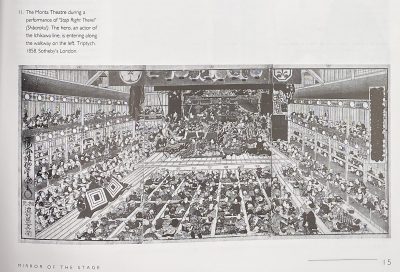
SVJP-0226.2016: Superb Edo pictures illustrating dances, 1858.
-
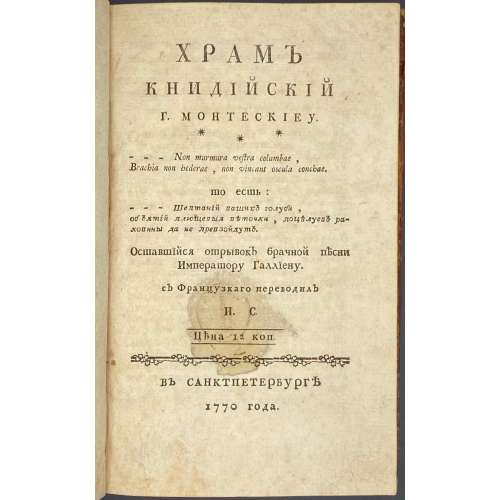 Шарль Монтескье. Храм Книдийский (пер. Иван Сичкарев). Лисимах. Разговор Суллы с Эвкратом. Опыт о вкусе (пер. Семён Башилов). — СПб.: [Тип. Акад. наук], 1770. Pagination: [2 blank] [2 t.p. храм, blank] [4 preface] [1] 2-72, [1, 2 t.p. лисимах, blank] [1] 2-12 [13, 14 t.p. силла] 16-33, [34 blank] [35, 37 t.p. опыт, blank] 38-95 [96 errata] [2 blank]. Size: 12mo, 20 x 12.5 cm, Binding: Contemporary polished brown slightly stained calf, gilt-ruled borders, flat spine with gilt bands and tools in compartments, black title label with gilt lettering to spine, marbled end-papers. Inscriptions and marks: Ink hand-writing to ff: "Люб. Дубенская, Москва XII 1931"; "Ленкнигторг" label glued to the recto of back free leaf; "Антикварная торговля В. И. Клочкова. СПБ., Литейный 55" label pasted to back pastedown. Printed on laid paper with "key" image printed on recto and protruding to the verso to t.p. of Храм Книдийский and Лисимах. Imperial orthography. Engraved head and tailpieces.
Шарль Монтескье. Храм Книдийский (пер. Иван Сичкарев). Лисимах. Разговор Суллы с Эвкратом. Опыт о вкусе (пер. Семён Башилов). — СПб.: [Тип. Акад. наук], 1770. Pagination: [2 blank] [2 t.p. храм, blank] [4 preface] [1] 2-72, [1, 2 t.p. лисимах, blank] [1] 2-12 [13, 14 t.p. силла] 16-33, [34 blank] [35, 37 t.p. опыт, blank] 38-95 [96 errata] [2 blank]. Size: 12mo, 20 x 12.5 cm, Binding: Contemporary polished brown slightly stained calf, gilt-ruled borders, flat spine with gilt bands and tools in compartments, black title label with gilt lettering to spine, marbled end-papers. Inscriptions and marks: Ink hand-writing to ff: "Люб. Дубенская, Москва XII 1931"; "Ленкнигторг" label glued to the recto of back free leaf; "Антикварная торговля В. И. Клочкова. СПБ., Литейный 55" label pasted to back pastedown. Printed on laid paper with "key" image printed on recto and protruding to the verso to t.p. of Храм Книдийский and Лисимах. Imperial orthography. Engraved head and tailpieces. -
 Title page: УТОПИЧЕСКИЙ РОМАН XVI – XVII ВЕКОВ | ТОМАС МОР | УТОПИЯ |•| КАМПАНЕЛЛА | ГОРОД СОЛНЦА |•| ФРЭНСИС БЭКОН | НОВАЯ АТЛАНТИДА |•| СИРАНО ДЕ БЕРЖЕРАК | ГОСУДАРСТВА ЛУНЫ |•| ДЕНИ ВЕРАС | ИСТОРИЯ СЕВАРАМБОВ | {PUBLISHER’S DEVICE} | ИЗДАТЕЛЬСТВО | «ХУДОЖЕСТВЕННАЯ ЛИТЕРАТУРА» | МОСКВА • 1971 || Pagination: [1-4] 5-493 [494] [2], 10 plates extraneous to collation. Collation: 16mo; [1]16 2-1516 168. Binding: 20.5 x 15 cm, burgundy cloth, gilt serial device to cover, gilt lettering to spine, pictorial DJ. Colophon: БИБЛИОТЕКА ВСЕМИРНОЙ ЛИТЕРАТУРЫ | СЕРИЯ ПЕРВАЯ | Том 34 || Print run 300,000 copies
Title page: УТОПИЧЕСКИЙ РОМАН XVI – XVII ВЕКОВ | ТОМАС МОР | УТОПИЯ |•| КАМПАНЕЛЛА | ГОРОД СОЛНЦА |•| ФРЭНСИС БЭКОН | НОВАЯ АТЛАНТИДА |•| СИРАНО ДЕ БЕРЖЕРАК | ГОСУДАРСТВА ЛУНЫ |•| ДЕНИ ВЕРАС | ИСТОРИЯ СЕВАРАМБОВ | {PUBLISHER’S DEVICE} | ИЗДАТЕЛЬСТВО | «ХУДОЖЕСТВЕННАЯ ЛИТЕРАТУРА» | МОСКВА • 1971 || Pagination: [1-4] 5-493 [494] [2], 10 plates extraneous to collation. Collation: 16mo; [1]16 2-1516 168. Binding: 20.5 x 15 cm, burgundy cloth, gilt serial device to cover, gilt lettering to spine, pictorial DJ. Colophon: БИБЛИОТЕКА ВСЕМИРНОЙ ЛИТЕРАТУРЫ | СЕРИЯ ПЕРВАЯ | Том 34 || Print run 300,000 copiesВступительная статья: Л. Воробьев
Томас Мор: Утопия. Перевод А. Малеина и Ф. Петровского.
Томмазо Кампанелла: Город Солнца. Перевод Ф. Петровского.
Фрэнсис Бэкон: Новая Атлантида. Перевод З. Александровой.
Сирано де Бержерак: Государства Луны. Перевод Е. Гунста.
Дени Верас: История Севарамбов. Перевод Е. Дмитриевой.
Примечания А. Малеина, Ф. Петровского, Ф. Коган-Бернштейн, Ф. Шуваевой.
Художник: Селиверстов, Юрий Иванович (Russian, b. 1940) Authors, translators:More, Sir Thomas (British, 1478 –1535)
Campanella, Tommaso (Italian, 1568 – 1639) Bacon, Francis (British, 1561 –1626) Cyrano de Bergerac, Savinien de (French, 1619 – 1655) Vairasse d' Allais, Denis (French, c. 1630 – 1672) Малеин, Александр Иустинович (Russian, 1869 – 1938) Петровский, Фёдор Александрович (Russian, 1890 – 1978) Елизавета Ивановна Дмитриева [Васильева; Черубина де Габриак] (Russian, 1887 – 1928) Александрова, Зинаида Николаевна (Russian, 1907—1983) Гунст, Евгений Анатольевич (Russian, 1901 – 1983) Коган-Бернштейн, Фаина Абрамовна [Аронгауз] (Russian, 1899 – 1976) -
![Гроций. О праве войны и мира // Общедоступная философия в изложении Аркадия Пресса. - СПб.: П. П. Сойкин, [1902].](https://varshavskycollection.com/wp-content/uploads/2021/02/LIB-0905.2015-3-500x500.jpeg) Front wrapper, t.p.: Общедоступная философiя | ВЪ ИЗЛОЖЕНИИ | АРКАДIЯ ПРЕССА | — | ГРОЦIЙ. | О ПРАВѢ ВОЙНЫ И МИРА. | Цена 40 коп. | [two medals] С.-Петербург | Изданiе П. П. Сойкина [two medals] | Книжный Складъ / Стремянная, 12 | Книжный Магазинъ / Невский, 96 || Verso to front wrapper: publisher's advert.; verso to back wrapper: publisher's advert.; back wrapper: Series advert. Series: Общедоступная философия в изложении Аркадия Пресса Pagination: [1, 2] – t.p. /censor's approval dated September 30, 1902 г., imprint, [3] 4-50 [2] – publisher's advert. Collation: 8vo; [1]8 2-38 42. Inscriptions: Handwriting to front wrapper "1902"; to title page "1902" and in Russian: "Ензику от Тышки 19/III-26г." Size: 19.5 x 12.3 cm. Binding: original publisher's wrappers, lettering, pp. 35-46 loose. Author: Hugo Grotius [Huig or Hugo de Groot] (Dutch, 1583 – 1645). Originally published by Nicolas Buon in Paris in 1625 in Latin under the title: De iure belli ac pacis (English: On the Law of War and Peace). Compiler/translator: Аркадий Германович Пресс [Аркадиус Пресас or Arkadius Presas] (Russian-Finish, 1870 – 1952).
Front wrapper, t.p.: Общедоступная философiя | ВЪ ИЗЛОЖЕНИИ | АРКАДIЯ ПРЕССА | — | ГРОЦIЙ. | О ПРАВѢ ВОЙНЫ И МИРА. | Цена 40 коп. | [two medals] С.-Петербург | Изданiе П. П. Сойкина [two medals] | Книжный Складъ / Стремянная, 12 | Книжный Магазинъ / Невский, 96 || Verso to front wrapper: publisher's advert.; verso to back wrapper: publisher's advert.; back wrapper: Series advert. Series: Общедоступная философия в изложении Аркадия Пресса Pagination: [1, 2] – t.p. /censor's approval dated September 30, 1902 г., imprint, [3] 4-50 [2] – publisher's advert. Collation: 8vo; [1]8 2-38 42. Inscriptions: Handwriting to front wrapper "1902"; to title page "1902" and in Russian: "Ензику от Тышки 19/III-26г." Size: 19.5 x 12.3 cm. Binding: original publisher's wrappers, lettering, pp. 35-46 loose. Author: Hugo Grotius [Huig or Hugo de Groot] (Dutch, 1583 – 1645). Originally published by Nicolas Buon in Paris in 1625 in Latin under the title: De iure belli ac pacis (English: On the Law of War and Peace). Compiler/translator: Аркадий Германович Пресс [Аркадиус Пресас or Arkadius Presas] (Russian-Finish, 1870 – 1952). -
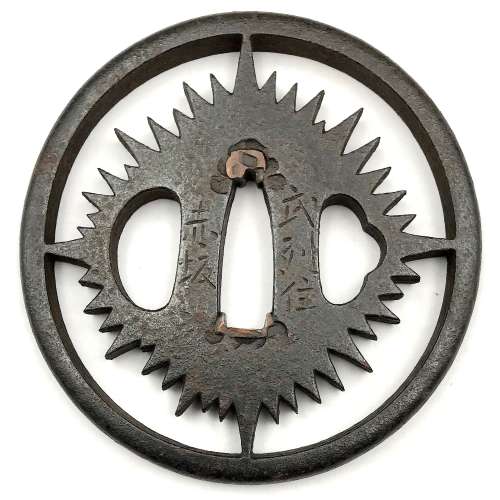 Iron tsuba of round form with slanting rays of light (shakoh) Christian motif (Jesuit’s IHS symbol) in openwork (sukashi). Traditional description of this kind of design is called “tokei”, or “clock gear”. Signed: On the face: Bushu ju Akasaka; On the back: Tadatoki Saku [Made by Tadatoki, resident of Bushu]. Probably, 4th generation of Akasaka School master Tadatoki (忠時), who died in 1746. Akasaka School. Edo period, first half of the 18th century. Size: 79.8 x 78.5 x 6.5 mm
Iron tsuba of round form with slanting rays of light (shakoh) Christian motif (Jesuit’s IHS symbol) in openwork (sukashi). Traditional description of this kind of design is called “tokei”, or “clock gear”. Signed: On the face: Bushu ju Akasaka; On the back: Tadatoki Saku [Made by Tadatoki, resident of Bushu]. Probably, 4th generation of Akasaka School master Tadatoki (忠時), who died in 1746. Akasaka School. Edo period, first half of the 18th century. Size: 79.8 x 78.5 x 6.5 mm -
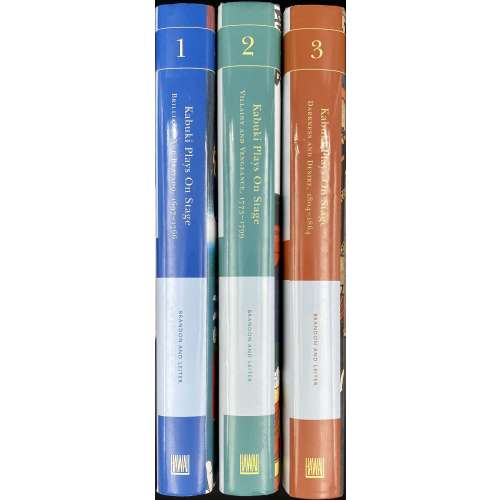 Three volumes, 26.2 x 18.6 cm each: Vol. 1: Kabuki plays on stage: Brilliance and Bravado, 1697-1766; pp.: [i-viii] ix-xiii [xiv blank], 1-391 [1 blank], total 203 leaves, ils. Blue buckram gilt-lettered on spine, pictorial DJ. Vol. 2: Kabuki plays on stage: Villainy and Vengeance, 1773-1799; pp.: [i-viii] ix-xiii [xiv blank], 1-413 [3 blank], total 215 leaves, ils. Green buckram gilt-lettered on spine, pictorial DJ. Vol. 3: Kabuki plays on stage: Darkness and Desire, 1804-1864; pp.: [i-viii] ix-xv [xvi blank], [1] 2-397 [3 blank], total 208 leaves, ils. Ochre buckram gilt-lettered on spine, pictorial DJ. (Vol. 4: Restoration and reform, 1872-1905 – absent for the reason of no interest in the covered period). Contributors: James Rodger Brandon (American, 1927 – 2015) Samuel L. Leiter (American, b. 1940)
Three volumes, 26.2 x 18.6 cm each: Vol. 1: Kabuki plays on stage: Brilliance and Bravado, 1697-1766; pp.: [i-viii] ix-xiii [xiv blank], 1-391 [1 blank], total 203 leaves, ils. Blue buckram gilt-lettered on spine, pictorial DJ. Vol. 2: Kabuki plays on stage: Villainy and Vengeance, 1773-1799; pp.: [i-viii] ix-xiii [xiv blank], 1-413 [3 blank], total 215 leaves, ils. Green buckram gilt-lettered on spine, pictorial DJ. Vol. 3: Kabuki plays on stage: Darkness and Desire, 1804-1864; pp.: [i-viii] ix-xv [xvi blank], [1] 2-397 [3 blank], total 208 leaves, ils. Ochre buckram gilt-lettered on spine, pictorial DJ. (Vol. 4: Restoration and reform, 1872-1905 – absent for the reason of no interest in the covered period). Contributors: James Rodger Brandon (American, 1927 – 2015) Samuel L. Leiter (American, b. 1940)


